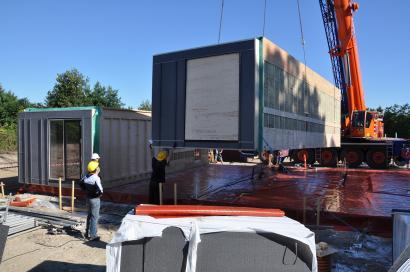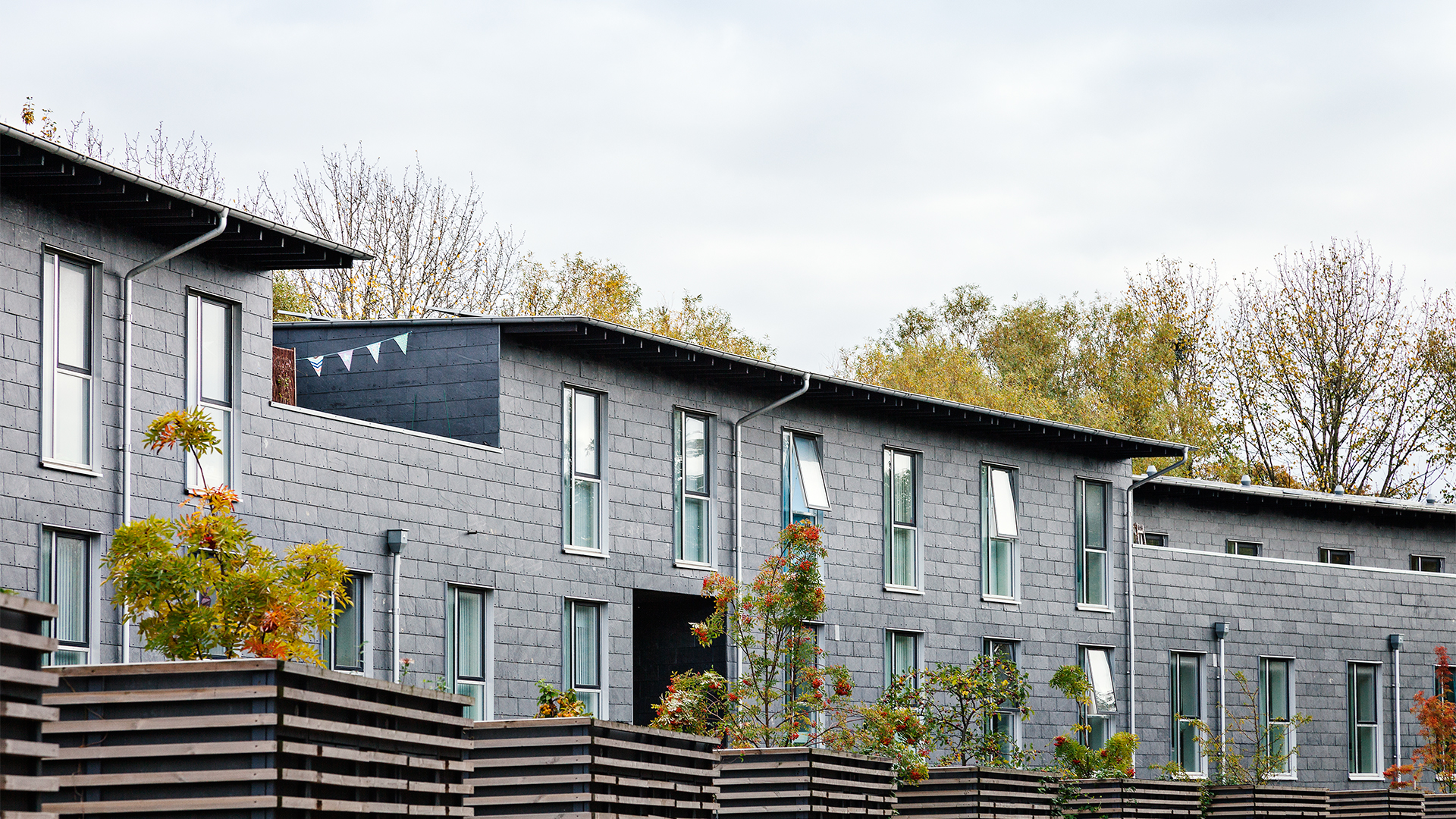Danmarkshusene
Danmarkshusene in Rødovre is part of the AlmenBolig+ development project, which is a new type of non-profit housing built and managed by the non-profit housing association KAB. When you want to balance low rent with newly built quality housing, you really only have one option in terms of construction: Modular and pre-fabricated construction. When KAB invited tenders for 72 family houses on Danmarksgrunden in Rødovre, Tegnestuen Vandkunsten was tasked with turning the architecture into a driver for an exciting housing project.
The average rent in AlmenBolig+ housing is 22 % lower than other comparable non-profit housing. In Danmarkshusene, the savings are achieved by minimising the costs of operation and maintenance – which the tenants are charged with – by means of energy optimisation and by optimising the level of pre-fabrication. The construction system is not just cheaper than conventional concrete housing – the resource consumption is also cut in half and the CO2 footprint is reduced by 68 %.
Economics & Resources
According to Vandkunsten Architects, the average rent in AlmenBolig+ housing is 22 % lower than in other comparable non-profit housing. This saving is achieved through energy optimisation and by replacing conventional and expensive craftsmanship with pre-fabrication. The construction system using room modules is not only cheaper than conventional concrete housing – the resource consumption is cut by half and it is more sustainable. The operating budget is kept low because money has been set aside for robust and long-life materials and because the residents are in charge of the maintenance and cleaning themselves.
Energy Efficienty & CO2 Footprint
Danmarkshusene have been constructed to energy class 2020. Most of the energy in the housing comes from photovoltaic cells and energy consumption is limited. All residential units have mechanical ventilation that recycles the heat from the air that is released from the units, the roof is fitted with solar panels that generate electricity for the entire housing. This results in an extremely low electricity bill. The on-account expenses for electricity only total DKK 450 per month per residential unit and cover both general electricity consumption and heating.
Both LCA and LCC calculations have been prepared for Danmarkshusene based on a calculation spanning 120 years. When the calculations are compared with reference housing that is similar in size, typology and consumption but made of conventional concrete structures, major financial savings and reduced negative environmental impact are revealed. According to Tegnestuen Vandkunsten, the LCA shows that the CO2 footprint of Danmarkshusene is only 32 % of the footprint of the reference housing. The LCC calculated for a span of 50 years shows that the lifecycle costs of Danmarkshusene are lower than the same costs of the reference housing, even considering that the conventional building materials used in the reference housing like brick and concrete have a long lifecycle and require a minimum of maintenance.
Quality of Life & Cohesion
Economic parameters have been decisive in the design of Danmarkshusene because cheap housing is a social asset. However, the housing also creates social value and cohesion in other ways. That is shown by an evaluation of AlmenBolig+’s concept and housing made by the Danish Building Research Institute in 2015. In order to get a low rent, the residents must be in charge of cleaning and maintenance. This means that the residents take good care of the place and form communities to deal with the various tasks.
The moving out rate is very low because the residents appear to be happy living there. According to the Danish Building Research Institute, the moving out rate is on average 1-5 % per year for most AlmenBolig+ housing, whereas 25-40 % is not uncommon in non-profit housing. The evaluation of AlmenBolig+ also shows that the tasks assumed by the residents help strengthen the sense of community in the housing and that the residents are generally very satisfied with both AlmenBolig+’s housing and concept.
“We’ve achieved really good neighbourly relations, because we must take care of the place together. People take an interest in each other because we are in this together. We feel as if it’s ours. And in return we get a better quality of life and sense of security because we keep an eye out for each other.” says Jette Baker Jakobsen, Chairman of the housing association at Danmarkshusene and a resident since 2013, the Danish Ministry of Immigration, Integration and Housing 2015.

About the case
Danmarkshusene is non-profit housing that might not be rich in extravagant details but is instead rich when it comes to utility value, sustainability and attractive neighbourly relations. AlmenBolig+ is synonymous with modular construction, and Tegnestuen Vandkunsten utilises the modules differently in each housing complex. For instance, on Danmarksgrunden in Rødovre, the modules are wedge-shaped, the area being characterised by a slanting wedge-shape that relates to the landscape around the embankment of Vestvolden and the nearby canal. Both areas are scenic with large and dense planting of trees.
Together, the slightly wedge-shaped box modules create a curve with 72 residential units in five rows. The external facade is made of slate, and the ground floor is covered in strips of cedar wood – both materials that require a minimum of maintenance. All residential units are designed in a simple layout and come with a bathroom, basic kitchen and electrical installations. This gives the residents ample opportunity to add their only personal touches, for instance by establishing internal walls, bedlofts, doors, etc. as they see fit.
